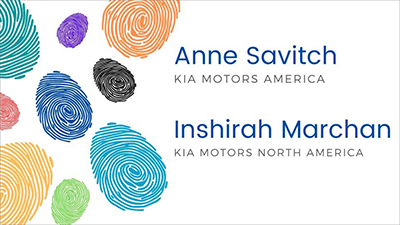Diversity, Equity and Inclusion (DE&I)

DiversityJobs.com Top Diversity Employer
SIRVA Is pleased to announce that we have been named a Top Diversity Employer by DiversityJobs.com. This award was given to a select group of employers that have shown consistent dedication to recruiting and hiring from all diversity groups.
Useful Resources
SIRVA’s Commitment/Mission Statement
At SIRVA, we’re committed to cultivating a workplace and an ecosystem that reflects the diversity of the global organisations that we serve. We recognise that building an inclusive, engaged company culture results in empowered employees that reflect a wide range of approaches and perspectives. Those perspectives lead to new ideas. New ideas lead to innovation and excellence. Our approach to diversity, equity and inclusion is driven by a commitment to these values and a belief that diversity makes our company stronger.

Ricky Aow
Sales & Account Management Business Analyst (Victoria, Australia)
This industry attracts passionate, down-to-earth people from diverse backgrounds, many of which who have been in the industry for 10, 20, 30+ years. I have a marvellous manager, who regularly takes time to update me, I enjoy the flexibility and challenges of the work. The business leaders are personally invested, dedicated, and bring energy and commitment to the team. Recently I was chuffed when a leader from a different business unit nominated me for a STAR award. The thing I treasure the most is the friendships I have made at SIRVA; friendships and memories that I will cherish
SIRVA's Employee Resource Groups (ERGs)
ERGs are employee-led, self-directed voluntary groups that offer opportunities to network internally, to attract a diverse employee base, to provide the inclusion of ideas and solutions, and to create opportunities for mentoring and career development.
SIRVA is proud to announce the formation of our first two Employee Resource Groups!

DEN –The Diverse Employee Network (People of Colour)
Mission: SIRVA People of Colour Employee Resource Group (ERG) is open to all employees. The ERG aims to advance a diverse and inclusive work environment with a particular focus on people of colour. Working with a dedicated network of diverse professionals, the ERG undertakes activities to attract, retain, empower and inspire employees of colour. These efforts are geared toward helping members gain leadership experience, get involved in the SIRVA community and develop new ideas to help drive SIRVA forward.
 SOL – SIRVA Out Loud (LGBTQ+)
SOL – SIRVA Out Loud (LGBTQ+)
Mission: Our mission is to create a safe and supportive space for LGBTQ+ SIRVA team members and their allies to thrive and be celebrated, so that we can provide advocacy for equity and an inclusive experience in all settings.

Recruiting & Outreach

- Internships
- Recruiting
- Partnerships
- Corporate Presence
Organisational Development

- Engagement
- Performance
- Promotions
- Pay Equity
Mentorship

- Career Development
- Interest Groups
Education & Training

- New Hire Onboarding
- Inclusiveness
- Standards & Training

Harriet Kwawukume
Client Finance Team Lead (Prague, Czech Republic)
“Being part of the SIRVA family has been a marvellous experience in my career growth. Having joined the finance team and getting to encounter the diverse multicultural environment has been great. SIRVA helped me to develop as an Analyst by investing in my skills and potential and bringing out the best in me and I’m currently leading one of the teams in finance. I foresee an empowering future here and I look forward to it!”
Mobilising Diversity: Customer Stories
Building and Leading Equitable and Inclusive Talent Management
Diversity, equity and inclusion (DE&I) is ever-evolving. There is no one-size-fits-all approach. In this three-part series, you will hear from three of our clients (Kia Engines, Ardent Mills and HPE). Our clients all have expertise in mobility and are helping change the landscape for DE&I efforts; they will share their stories as an effort to help other organisations learn from peers on how DE&I intersects with mobility and talent management.
Virtual Household Goods Surveys
An Assessment of the “New Norm” in Moving
Household goods (HHG) surveys have always been the important first step in an employee’s moving process. Once a move was initiated, the moving company would contact the assignee or transferee to arrange an in-home meeting. Though certainly intended to assess the amount and type of goods to be moved, the visit also addressed an equally important goal: to establish the type of first impression and relationship that would foster confidence and minimise anxiety during what is widely considered to be one of the most stressful events in a person’s life – moving. The wake of COVID-19 has forced moving companies to replace the in-home HHG survey with virtual ones. Are these virtual surveys capable of capturing an accurate picture of an assignee/transferee’s HHGs? Do they allow for the type of relationship building that moving companies count on? What can organisations do to ensure that their employees are receiving the best service during this critical phase of a move?
Assessing the Virtual Survey Process
Because virtual surveys have become a new norm, we wondered how they might compare to in-person HHG surveys:
- How easy is it to book and confirm a virtual survey on a preferred date?
- How easy is it to use the technology?
- What interfaces are required to use the technology?
- Does the survey result in an accurate inventory of items that can be used by the moving company/relocation management company?
- Does the encounter result in an employee’s feeling of comfort and confidence regarding the process?
As mentioned at the start of this blog post, historically, the HHG survey has been highly valued as the first contact an employee has with the moving company. Put simply, that first perception sets the tone for the entire moving process. The move to a virtual survey has truly redefined the service in our industry, overall, so we wanted to experience that service through the eyes of an assignee/transferee. Ultimately, we wanted to determine what impact, if any, separating the surveyor and employee by a digital device would have on both the survey process and resulting perceptions on the part of the employee.
 Vendor Similarities and Differences
Vendor Similarities and Differences
To find answers to these questions, SIRVA Account Director Jennifer Garcia conducted test surveys with three virtual survey vendors. During each appointment, she immersed herself fully into the process using her own home as a consistent example. Detailed results of the survey tests can be viewed in a recording of a webinar co-hosted by SIRVA and Worldwide ERC. A brief summary of our findings is shown below.
Similarities
For the most part, all three vendors had a similar process. Using a mobile phone, users:
- Select and schedule a survey date and time
- Receive a confirmation regarding the scheduled appointment, usually via email
- Are instructed to download the vendor’s virtual survey app
- Receive reminder texts prior to and the day of the virtual appointment
- Utilise their mobile phone’s built in camera to show surveyors the contents of their home
Technological aspects were also fairly similar and could be broken down into three basic functions/interfaces:
- The app and survey company interface for booking the appt and carrying out the survey
- The handheld device being used by the employee, to transmit visual images to the surveyor during a real-time, virtual survey
- The technology used to aggregate information and present the results of the survey back to the moving company
While there were some differences regarding each app’s look, feel and functionality, common advantages included a welcome ability to schedule a survey with a click of a button at any time of day, with slots available after midnight. Easy accessibility, provided the user had a Wi-Fi signal, was also a benefit. All survey companies required the user to agree to terms and conditions that were designed to protect both the user and the surveyor, and all three vendors agreed not to distribute any information gathered via the app or survey without approval.
Prior to the Survey:Mobility professionals should advise the employee to:1. Place their phone in DND mode to avoid interruptions from unwanted pop-up notifications 2. Minimise clutter and organise shelves and cupboards so surveyors have a clear understanding of what will need to be moved (swept floors won’t help surveyors to assess the true amount of a homeowner’s HHGs, but clearly seeing organised items in a cupboard or on shelves will) 3. Remember that the survey will begin with a virtual face-to-face introduction (this will provide the employee with advance notice so they can dress in a way that would make them comfortable for the virtual meeting) |
Differences
While the style and functionality of the surveys varied in some minor ways (from where and how appointment confirmations were provided to how rooms were defined) there were notable differences in both the way the surveys were conducted and the interpersonal styles of the individuals conducting them. It’s these differences that we feel can “make or break” the moving experience.
Preparation and Organisation
Knowing how to plan for the packing, crating, loading and moving of household goods is dependent on a successful estimate of the amount and weight of the HHGs that will need to be moved. In short, the virtual survey must acquire an accurate inventory to build a move plan for both the employee and the moving company. The employee’s ability to accurately represent their HHGs will be key to a successful assessment. All three vendors did recommend having a tape measure and torch available to provide a sense of scale and/or see items in darker areas that might need illumination. However, only one vendor – the vendor that consistently stood out as exceptional amongst all three – did say that some advance organisation of cupboards, shelves, etc. would be helpful.

Valuables and Custom Crating
Crating, particularly custom crating, can be costly, so it’s important that surveyors and employees reach a mutual understanding on which items will be crated and what the cost will be. The lists of standard items for crating varied greatly from vendor to vendor but, again, one stood out as a winner in our opinion by having a proactive conversation with our account director about the definition of “an item of value”. Looking past an object’s monetary value, the vendor added that an object of value should be defined as any item that had a perceived value for the employee. The other vendors didn’t address valuables or crating at all during the survey.
Training and Empathy
Despite years of experience and preparing employees for their in-person HHG surveys, Jennifer found herself nervous before her virtual appointments. Had she organised her belongings well enough to provide an accurate inventory of her household goods? Would she need to lead the walkthrough? What if she missed something? Since moving is considered to be one of the most stressful events in a person’s life, it’s very important that the surveyor guiding a virtual survey be well-trained, patient and likeable to set employees at ease and guide the process effectively. During Jennifer’s test surveys two of the surveyors were professional and prepared, but one seemed dishevelled, distracted and rushed. Of the two more professional vendors, the front-runner emerged as exceptional, again, by quickly establishing a warm rapport and offering helpful guidance on the best angles and places to begin recording to capture an accurate inventory of her belongings.
Time Spent
The time surveyors spent on each virtual survey varied, with a range of 15 minutes to a full hour. We concluded that anything under 30 minutes seemed far too short to accurately inventory a house of over 3,000 square feet. The vendor that spent the most time, and that was previously mentioned as outstanding in other areas, was also the most thorough, organised, informative and, most importantly, empathetic. The time spent during the survey wasn’t just reflected in the accuracy of the inventory results, it was also reflected in Jennifer’s comfort level and confidence that the move would go well. Given the choice, she would have chosen this vendor for her move.
Choosing the Right Virtual Survey Vendor
Of course, employees don’t typically have a choice of virtual survey vendor. This is typically decided by the employer or moving company. Herein lies the challenge: If successful moves are dependent on accurate inventories and employee comfort level, and the level of the surveyor’s professionalism and skill can vary from vendor to vendor, how can employers ensure that their employees are working with the best virtual survey companies?
If the company is managing their virtual surveys ‘in-house’, it’s important to remember that the very insertion of a digital device between the surveyor and moving employee changes the process dramatically. Individual surveyors must be adept at establishing trust and rapport over the phone, which calls for the consideration of new ways to make interpersonal connections, knowing what types of humour do and don’t work in this new medium, and finding new ways to establish familiarity and comfort with the moving employee.
Relocation management companies (RMCs) have emerged as a strong partner to organisations when it comes to virtual surveys, thanks to their extensive network of vendors. SIRVA, for example, evaluates vendors in all divisions of our network. Conducting assignee/transferee satisfaction surveys and regularly assessing the accuracy of virtual surveys allows experienced providers to examine data that further allows them to rate providers according to their performance in the areas of cadence of rapport, professionalism and skill.
As an experienced integrated relocation and moving company, SIRVA is able to assign the right moving resources based on location and need. Through that understanding of needs, we can also assign the best qualified virtual surveyor in any location in the world. Additionally, our wealth of experience helps us to curate tailored dialogue that surveyors should have with each employee based on regional nuances, cultural differences, job level, etc.
Start off on the Right Foot
A poorly managed survey can cause a myriad of problems for organisations, their employees, and the moving companies themselves. When employees doubt the ability of a moving company to safely manage their belongings, their resulting stress can lead to more administrative activity on the part of the employer and relocation management company – and less focus on job roles on the part of the employee. An incorrect inventory of household contents can result in a shortage of packing materials or incorrectly sized moving vehicles and/or containers at the time of the move. Unexpected costs and tensions can arise at a time when the importance of managing relocations costs is more highly prized than ever before. Maximising employee productivity for the moving employee and minimising miscommunications and stress are key to ensuring a smooth relocation.
Since all of this depends on the successful implementation of a friendly, thorough virtual survey, ensuring that your employee meets with a virtual surveyor who is knowledgeable and skilled at establishing a bond is very important. In the end, Jennifer’s experience showed us that her comfort level was the most important factor regarding her perception of a pending move.
“The experience with each survey set the tone for the entire experience”, said Jennifer. “Likeable face-to-face contact put me at ease, while the surveyor who seemed rushed and inattentive made me feel as though I wasn’t important to the people who would be moving me. Based on the three different approaches to the survey, I can say that when the surveyor spends time and attention establishing an affinity with the assignee/transferee; providing calm, two-way communication; and guiding the experience in a knowledgeable manner, the process seems manageable, controlled and supported with the correct level of expertise. As a result, the employees who are moving will be more confident in the process, surprises can be avoided, and they can benefit, along with their corporate sponsors and moving companies, from the right services being supplied at the correct price.”
Contributors:
Lisa Marie DeSanto, Content Marketing Manager
Jennifer Garcia, Director, SMM Account Management





